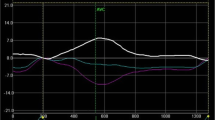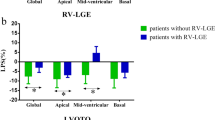Abstract
Objectives: We aimed to characterize regional geometry in relation to load in two groups of patients with hypertrophic cardiomyopathy (HCM) and right ventricular pressure overload (RVPO) in relation to a group of subjects with normal left ventricular (LV) function. Background: Both these diseases are associated with marked changes in LV shape and function, which have not been studied with detailed three dimensional tools. Methods: Three dimensional (3D) tagged magnetic resonance imaging (MRI) was used to characterize the 3D geometry and regional stresses of the left ventricles in patients with HCM and RVPO. Curvatures, stresses, wall thickness, and endocardial motion were calculated from surface and volume elements. Results: Hearts with RVPO exhibited more circumferential and meridional flattening of the septum than normal and HCM hearts. The stress indices were lowest in the HCM hearts, compared to normal and RVPO hearts, due to the larger thicknesses. There was a more significant difference between lateral wall motion and other regional wall motions in the HCM and RVPO hearts as compared to normal hearts. Conclusions: It is suggested that curvature and stress mapping by 3D tagged MRI can be used as an important clinical tool for characterizing and distinguishing between healthy and diseased hearts. The results provided here validated previous knowledge on HCM and RVPO known from planary imaging methods.
Similar content being viewed by others
References
King ME, Braun H, Goldblatt A, Liberthson R, Weyman AE. Interventricular septal configuration as a predictor of right ventricular systolic hypertension in children: A cross-sectional echocardiographic study. Circulation 1983; 68: 68-75.
Dong S-J, Crawley AP, MacGregor JH, et al. Regional left ventricular systolic function in relation to the cavity geometry in patients with chronic right ventricular pressure overload; a three-dimensional tagged magnetic resonance imaging study. Circulation 1995; 91: 2359-70.
Louie EK, Rich S, Brundage B. Doppler echocardiographic assessment of impaired left ventricular filling in patients with right ventricular pressure overload due to primary pulmonary hypertension. J Am Coll Cardiol 1986; 8: 1289-1306.
Goto Y, Slinker BK, LeWinter MM. Nonhomogeneous left ventricular regional shortening during acute right ventricular pressure overload. Circ Res 1989; 65: 43-54.
Dittrich HC, Chow LC, Nicod PH. Early improvement in left ventricular diastolic function after relief of chronic right ventricular pressure overload. Circulation 1989; 80: 823-30.
Little WC, Badke FR, O'Rourke RA. Effect of right ventricular pressure on the end diastolic left ventricular pressure-volume relationship before and after chronic right ventricular pressureoverload in dogs without pericardia. Circ Res 1984; 54: 719-30.
Kingma I, Tyberg JV, Smith ER. Effect of diastolic trans-septal pressure gradient on ventricular septal position and motion. Circulation 1983; 68: 1304-14.
Dong S-J, MacGregor JH, Crawley AP, et al. Left ventricular wall thickness and regional systolic function in patients with hypertrophic cardiomyopathy, a three-dimensional tagged magnetic resonance imaging study. Circulation 1994; 90: 1200-9.
Hayashida W, Kumada T, Kohno F, et al. Left ventricular relaxation and its nonuniformity in hypertrophic nonobstructive cardiomyopathy. Circulation 1991; 84: 1496-1504.
Kramer CM, Reichek N, Ferrari VA, Theobald T, Dawson J, Axel L. Regional heterogeneity of function in hypertrophic cardiomyopathy. Circulation 1994; 90: 186-94.
Young AA, Kramer CM, Ferrari VA, Axel L, Reichek N. Three-dimensional left ventricular deormation in hypertrophic cardiomyopathy. Circulation 1994; 90: 854-67.
Zerhouni EA, Parish DM, Rogers WJ, Yang A, Shapiro EP, Human heart tagging with MR imaging: A method for noninvasive assessment of myocardial motion. Radiology 1988; 169: 59-63.
Lessick J, Sideman S, Azhari H, Shapiro E, Weiss JL, Beyar R. Evaluation of regional load in acute ischemia by three-dimensional curvatures analysis of the left ventricle. Annals Biomed Eng 1993; 21: 147-61.
Janz RF. Estimation of local myocardial stress. Am J Physiol 1982; 242: H875-81.
Beyar R, Shapiro EP, Graves WL, et al. Quantification and validation of left ventricular wall thickening by a three-dimensional volume element magnetic resonance imaging approach. Circulation 1990; 81: 297-307.
Maier SE, Fischer SE, McKinnon GC, Hess OM, Krayenbuehl HP, Boesiger P. Evaluation of left ventricular segmental wall motion in hypertrophic cardiomyopathy with myocardial tagging. Circulation 1992; 86: 1919-28.
Author information
Authors and Affiliations
Rights and permissions
About this article
Cite this article
Petrank, Y.F., Dong, S.J., Tyberg, J. et al. Regional differences in shape and load in normal and diseased hearts studied by three dimensional tagged magnetic resonance imaging. Int J Cardiovasc Imaging 15, 309–321 (1999). https://doi.org/10.1023/A:1006132709895
Issue Date:
DOI: https://doi.org/10.1023/A:1006132709895




